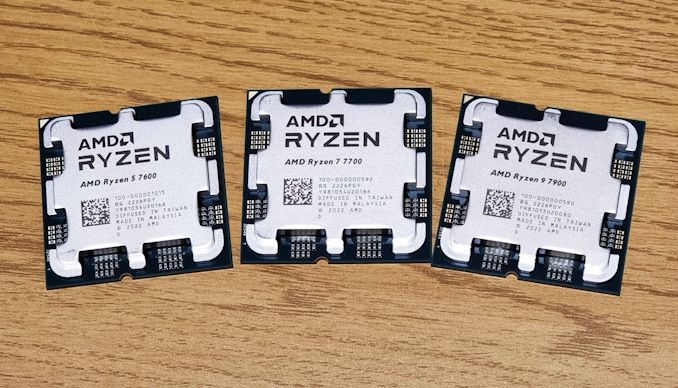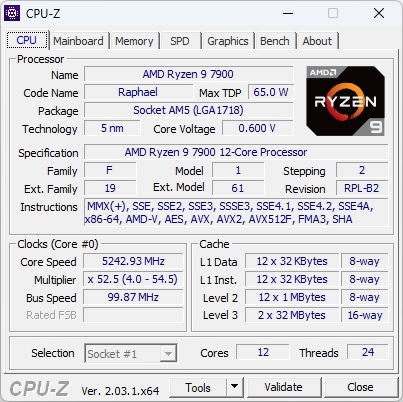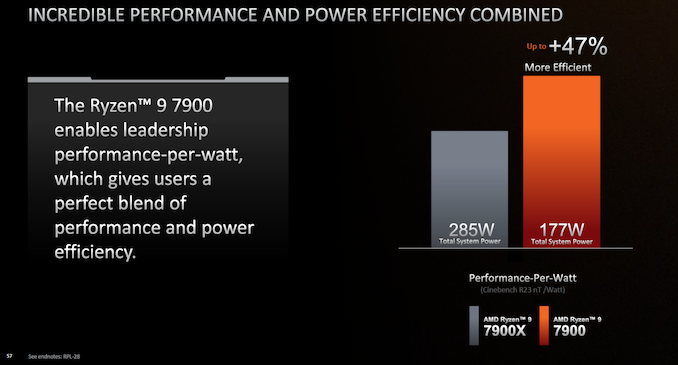The AMD Ryzen 9 7900, Ryzen 7 7700, and Ryzen 5 7600 Review: Zen 4 Efficiency at 65 Watts
by Gavin Bonshor on January 9, 2023 9:00 AM EST
In Q3 of last year, AMD released the first CPUs based on its highly anticipated Zen 4 architecture. Not only did their Ryzen 7000 parts raise the bar in terms of performance compared with the previous Ryzen 5000 series, but it also gave birth to AMD's latest platform, AM5. Some of the most significant benefits of Zen 4 and the AM5 platform include support for PCIe 5.0, DDR5 memory, and access to the latest and greatest of what's available in controller sets.
While the competition at the higher end of the x86 processor market is a metaphorical firefight with heavy weaponry, AMD has struggled to offer users on tighter budgets anything to sink their teeth into. It's clear Zen 4 is a powerful and highly efficient architecture, but with the added cost of DDR5, finding all of the components to fit under tighter budget constraints with AM5 isn't as easy as it once was on AM4.
AMD has launched three new processors designed to offer users on a budget something to get their money's worth, with performance that make them favorable for users looking for Zen 4 hardware but without the hefty financial outlay. The AMD Ryzen 9 7900, Ryzen 7 7700, and Ryzen 5 7600 processors all feature the Zen 4 microarchitecture and come with a TDP of just 65 W, which makes them viable for all kinds of users, such as enthusiasts looking for a more affordable entry-point onto the AM5 platform.
Of particular interest is AMD's new entry-level offering for the Ryzen 7000 series: the Ryzen 5 7600, which offers six cores/twelve threads for entry-level builders looking to build a system with all of the features of AM5 and the Ryzen 7000 family, but at a much more affordable price point. We are looking at all three of AMD's new Ryzen 7000 65 W TDP processors to see how they stack up against the competition, to see if AMD's lower-powered, lower-priced non-X variants can offer anything in the way of value for consumers. We also aim to see if AMD's 65 W TDP implementation can shine on TSMC's 5 nm node process with performance per watt efficiency that AMD claims is the best on the market.
Over the last year, since AMD unveiled its Zen 4 core, we've published several column inches on the microarchitecture, Ryzen 7000 processors, and the AM5 platform. Below is a list of our detailed Raphael (Zen 4) and Ryzen 7000 coverage:
- AMD Zen 4 Ryzen 9 7950X and Ryzen 5 7600X Review: Retaking The High-End
- AMD's Desktop CPU Roadmap: 2024 Brings Zen 5-based "Granite Ridge"
- Updated AMD Notebook Roadmap: Zen 4 on 4nm in 2023, Zen 5 By End of 2024
- AMD Zen 4 Update: 8% to 10% IPC Uplight, 25% More Perf-Per-Watt, V-Cache Chips Coming
Ryzen 9 7900, Ryzen 7 7700, Ryzen 5 7600, 65 W TDP from $229
Focusing on the latest 65 W-based Ryzen 7000 series processors, AMD is looking to offer better value throughout its series in addition to the various price drops on its X-class Zen 4 chips across the board. The new Ryzen 7000 non-X series chips are available across multiple configurations and price points, some of which show better power efficiency against previous generations of its processors and the decision to go back to bundling suitable coolers for even more value.
In contrast to AMDs top X-series SKUs, which require competent cooling due to the higher power consumption and higher thermal pressure placed on the IHS, the new 65 W models are designed with efficiency and performance per watt in mind. All of which is intended to make them (more) viable options for all types of system builders. To account for the lower TDP compared with the X-series SKUs, AMD has lowered their clockspeed expectations for these new SKUs. The boost clocks are still fairly high, reflecting what the silicon can do in lighter workloads; but the official base frequency clock speeds have been more significantly cut in order to keep the chips' power usage under control in more heavily multi-threded scenarios.
| AMD Ryzen 7000 Series Line-Up | ||||||||
| AnandTech | Cores Threads |
Base Freq |
Turbo Freq |
Memory Support |
L3 Cache |
TDP | PPT | MSRP |
| Ryzen 9 7950X | 16C / 32T | 4.5 GHz | 5.7 GHz | DDR5-5200 | 64 MB | 170 W | 230 W | $699 |
| Ryzen 9 7900X | 12C / 24T | 4.7 GHz | 5.6 GHz | DDR5-5200 | 64 MB | 170 W | 230 W | $549 |
| Ryzen 9 7900 | 12C / 24T | 3.6 GHz | 5.4 GHz | DDR5-5200 | 64 MB | 65 W | 88 W | $429 |
| Ryzen 7 7700X | 8C / 16T | 4.5 GHz | 5.4 GHz | DDR5-5200 | 32 MB | 105 W | 142 W | $399 |
| Ryzen 7 7700 | 8C / 16T | 3.6 GHz | 5.3 GHz | DDR5-5200 | 32 MB | 65 W | 88 W | $329 |
| Ryzen 5 7600X | 6C / 12T | 4.7 GHz | 5.3 GHz | DDR5-5200 | 32 MB | 105 W | 142 W | $299 |
| Ryzen 5 7600 | 6C / 12T | 3.8 GHz | 5.1 GHz | DDR5-5200 | 32 MB | 65 W | 88 W | $229 |
Starting with the top 65 W SKU from AMD, the Ryzen 9 7900 has twelve Zen 4 cores with a maximum boost clock speed of up to 5.4 GHz. In addition, it shares the same 64 MB L3 cache as the Ryzen 9 7950X and Ryzen 9 7900X, but with a TDP over 100 Watts lower than the flagship model. The Ryzen 9 7900 is designed for content creators, gamers, and enthusiasts looking for a more affordable option.
Directly comparing the Ryzen 9 7900 to the Ryzen 9 7900X, the 65 W variant has a base clock speed of 3.6 GHz, which is a drop of around 23% compared to its X-series sibling. On the other hand, the boost clock speeds are much more similar, with a 5.4 GHz boost frequency on the Ryzen 9 7900, making things more palatable for enthusiasts.

AMD Ryzen 9 7900 12-core/24-thread processor in CPU-Z
The 61% drop in TDP between the Ryzen 9 7900 (65 W) and Ryzen 9 7900X (170 W) may pose some questions surrounding raw performance throughput. Certainly, the 7900 is going to see lower performance in heavily multi-threaded workloads; you still need a lot of power to light up a dozen Zen 4 cores at 5GHz+. The up side to this, however? Having a lower TDP makes it more viable in systems with space constraints. Not only this, but it also means it's easier to cool and alleviates some budget needed for purchasing a high-end cooler, which could be spent on faster DDR5 memory, storage, or discrete graphics.
Moving down the stack to the Ryzen 7 series, the Ryzen 7 7700 has the same core and thread count as the existing Ryzen 7 7700X, but with a 100 MHz hit to boost clock speeds. Meanwhile there's the base frequency of 3.6 GHz, which does constitute a drop in raw frequency of 900 MHz. Other features include a total cache of 40 MB, 32 MB of L3 cache, and 8 MB of L2 cache.
Overall, the Ryzen 7 7700 sees a 40 W drop in TDP versus its 105 TDP of its X-series counterpart, which is notably smaller than the drop on the 7900 parts. So the Zen 4 hardware isn't being asked to give up quite as much performance headroom here.

Slide from AMD's Ryzen 7000 65 W Slide Deck: Performance-Per-Watt is the focus
The final SKU from AMD's Ryzen 7000 65 W offerings is the Ryzen 5 7600. The Ryzen 5 7600 is the entry-level model of AMD's latest high-performance AM5 platform, with six cores and a maximum boost clock speed of 5.1 GHz. It shares many of the characteristics of the Ryzen 5 7600X, including 32 MB of L3 cache with 6 MB of L2 cache; this is 1 MB per core which is a benefit of Zen 4 over the 512 KB of L2 cache per core on Zen 3. The other benefit is the price, of which the Ryzen 5 7600 is very attractive, with an entry-level price of $229, down from the $299 MSRP (and $269 street price) of the 7600X. This allows users looking to opt for a Zen 4 and TSMC 5 nm processor an even more affordable option to consider opting for.
Like the rest of the Ryzen 7000 family, all three of the new 65 W SKUs also include an integrated GPU made of two RDNA2-based CUs, in order to provide basic levels of integrated graphics. While more than satisfactory for simple desktop needs, these shouldn't be confused with having the same levels of graphical power as their Ryzen series of APUs.
Finally, it's also worth reminding everyone that, as has been the case for several processor generations now, TDP is not the maximum power consumption value for either AMD or Intel – nor is the definition of TDP even identical between the two. For AMD, the metric to watch is Package Power Tracking (PPT), which is the power level that the CPU socket allows the CPU to draw in terms of power. On the AM5 platform, AMD defines PPT as being 1.35x the TDP – so in the case of today's 65 W Ryzen processors, that means an 88 W socket power limit.
Test Bed and Setup
Per our processor testing policy, we take a premium category motherboard suitable for the socket and equip the system with a suitable amount of memory running at the manufacturer's maximum supported frequency. This is also typically run at JEDEC sub-timings where possible. It is noted that some users are not keen on this policy, stating that sometimes the maximum supported frequency is relatively low, or faster memory is available at a similar price, or that the JEDEC speeds can be prohibitive for performance.
While these comments make sense, ultimately, very few users apply memory profiles (either XMP or other) as they require interaction with the BIOS. Most users will fall back on JEDEC-supported speeds - this includes home users and industry who might want to shave off a cent or two from the cost or stay within the margins set by the manufacturer. Where possible, we will extend out testing to include faster memory modules either at the same time as the review or at a later date.
The Current CPU Test Suite
For our AMD Ryzen 9 7900, Ryzen 7 7700, and Ryzen 5 7600 testing, we are using the following test system:
| AMD Ryzen 7000 Series System (DDR5) | |
| CPU | Ryzen 9 7900 ($429) 12 Cores, 24 Threads 65 W TDP Ryzen 7 7700 ($329) 8 Cores, 16 Threads 65 W TDP Ryzen 5 7600 ($229) 6 Cores, 12 Threads 65 W TDP |
| Motherboard | GIGABYTE X670E Aorus Master (BIOS 813b) |
| Memory | G.Skill Trident Z5 Neo 2x16 GB DDR5-5200 CL44 |
| Cooling | EK-AIO Elite 360 D-RGB 360 mm AIO |
| Storage | SK Hynix 2TB Platinum P41 PCIe 4.0 x4 NMve |
| Power Supply | Corsair HX1000 |
| GPUs | AMD Radeon RX 6950 XT, Driver 31.0.12019 |
| Operating Systems | Windows 11 22H2 |
Our updated CPU suite for 2023 includes various benchmarks, tests, and workloads designed to show variance in performance between different processors and architectures. These include UL's latest Procyon suite with both office and photo editing workloads simulated to measure performance in these tasks, CineBench R23, Dwarf Fortress, Blender 3.3, and C-Ray 1.1.
Meanwhile, we've also carried over some older (but still relevant/enlightening) benchmarks from our CPU 2021 suite. This includes benchmarks such as Dwarf Fortress, Factorio, and Dr. Ian Cutress's 3DPMv2 benchmark.
We have also updated our pool of games going forward into 2023 and beyond, including the latest F1 2022 racing game, the CPU-intensive RTS Total War: Warhammer 3, and the popular Hitman 3.










55 Comments
View All Comments
iRacer - Wednesday, February 1, 2023 - link
How do you get V-Ray benchmark values which are 35 to 50% higher than anything that can be seen on the results page?What version of the benchmark are you using?
leavenfish - Sunday, February 5, 2023 - link
Ummm....don't think he ever did the testing update he said he would try to do (but was busy) the weekened after the article came out?Gavin Bonshor - Monday, February 6, 2023 - link
It's coming, don't worry.Gavin Bonshor - Monday, February 6, 2023 - link
It isn't the latest iteration. It's the previous version (4). The critical area to consider is the consistency of the results within the same version.Of course, we will update this benchmark in our next wave to the latest version. If we did this for every benchmark, I would spend 100% of my time testing and 0% writing.
blueryu - Tuesday, February 7, 2023 - link
I'd like to know the idle power consumption of the CPUs. Apparently there is quite a difference at idle between the latest AMD and Intel options but can't seem to find much in the way of tests.